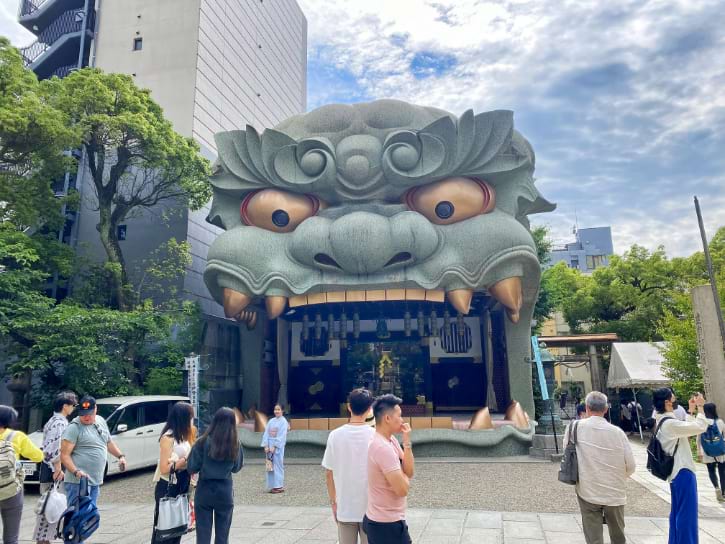
Namba Yasaka Shrine in Osaka is a special place full of surprises. This guide will show you its famous lion head and tell you why so many people love it.
You’ll discover the charm of this unique shrine in the bustling city. And believe me, this spot is a must when organizing your Osaka itinerary.
Ready for an exciting and memorable visit? Let’s explore! 😊
- Namba Yasaka Shrine Overview and Highlights
- Two Essential Sights to Experience at the Shrine
- Purification Ritual: How It’s Done at the Shrine
- Steps and Rituals for Making a Prayer
- Engaging with Ema: Personal Wishes and Cultural Practices
- How to Get to Namba Yasaka Shrine
- Opening Hours
- Entrance Fee
- Next Stops After Namba Yasaka Shrine: Osaka’s Must-See Spots
- Related Posts
Namba Yasaka Shrine Overview and Highlights

1. When Was the Shrine Built
Namba Yasaka Shrine is also referred to as “Namba Shimo no Miya”, by the locals. Many believed that the shrine was constructed during the reign of Emperor Nintoku between 313 to 399.
The exact founding date is unclear because of the big air attack on Osaka in 1945. At that time, the shrine sustained significant damages that erased its exact history.
2. Why Is the Shrine Special
There’s a story about a god named Gozutenno. He’s known for stopping epidemic diseases a long time ago.
Because of his help and kind heart, people started worshipping him. The locals gave homage to him through the shrine.
3. Connection to Another Shrine
Fascinatingly, the main shrine is Yasaka Shrine, which is located in Kyoto.
4. The Gates of the Shrine
Namba Yasaka Shrine features three distinct torii gates. The first one faces the main shrine on the south side while the second gate is set on the eastern section facing the Shishiden shrine.
You can find the last Torii gate on the west side. Each gate comes with a special design that corresponds to a distinct meaning.
Two Essential Sights to Experience at the Shrine
1. Main Hall Mysteries: Unveiling the Sacred Deities and Their Blessings
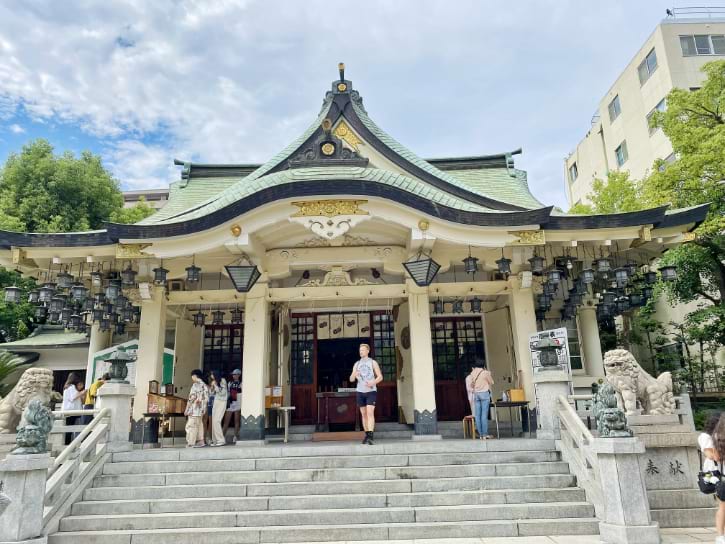
Upon arrival at the main shrine, explore around and discover the three 3 deities inside. These are Susanoo-no-Mikoto, Kushinada-hime-no-Mikoto, and Yahashiramiko-no-Mikoto.
a. Susanoo-no-Mikoto
As one of the Three Noble Gods, people pray to Susanoo-no-Mikoto for protection against bad spirits.
Locals also offer pray to him for business growth, particularly farming. He is also the younger brother of the Sun Goddess, Amaterasu.
b. Kushinada-hime-no-Mikoto
People offer a prayer to Susanoo’s wife, Kushinada-hime-no-Mikoto, for a loving relationship and a blissful marriage. Families also call upon the goddess for a safe childbirth.
Before being a goddess, she was rescued by Susanoo from being sacrificed to the giant eight-headed snake.
c. Yahashiramiko-no-Mikoto
The Eight Generals, also known as Yahashiramiko, were the eight princes born to the god Susanoo and the goddess Kushinada. Just like their parents, these deities are prayed by the locals.
2. Giant Lion Head: The Iconic Masterpiece of the Shrine
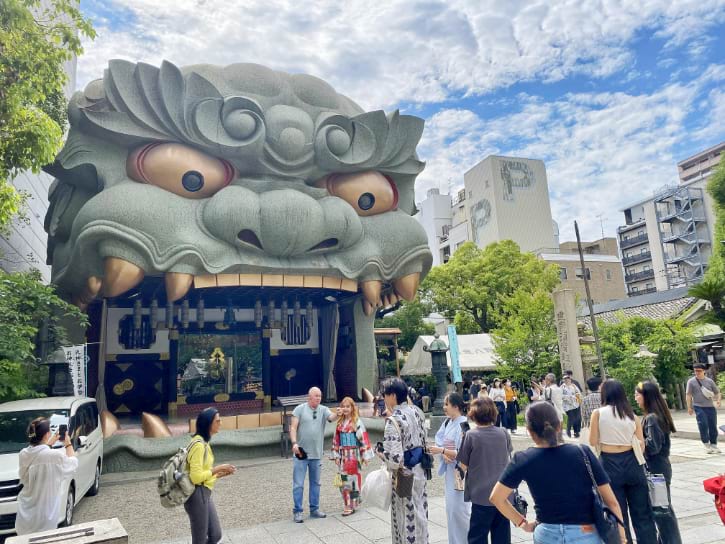
a. Giant Lion Head: A Symbol of Awe and Wonder
Stop by this iconic attraction that stands at 12 meters tall and 11 meters wide. The Giant Lion is one of the most popular structures in the shrine because of its enormous size.
Beyond its remarkable dimensions, it also comes with a cultural significance.
The lion head serves as protection from bad spirits and is an important symbol for the locals in Osaka. In the past, lion dances were also common in the area.
b. Inside the Majestic Lion: A Blend of Spirituality and Artistry
Glance at the golden eyes of the lion and check out its teeth made of brass.
And if you look closer inside the lion head structure, you’ll see a small shrine. This shrine has statues of Susanoo-no-Mikoto’s spirit and two lion heads called Kaga-jishi.
Don’t forget to take a look at the exceptional phoenix pattern on the shrine’s ceiling. What makes this more unique is the fact that the design was carved by hand.
c. Your Wishes and Hopes at the Giant Lion Head
Before heading to the next destination, pay homage to the lion head and pray for good luck. Many locals visit here for success in exams, business, and work.
Purification Ritual: How It’s Done at the Shrine

Every time you pass through the Torii gate, you’ll come across an ancient water basin.
Since there are three entrances to the shrine, there are also several purification rituals inside the religious complex.
When you see the water basin, try to follow the formalities below.
- Slightly bow towards the water basin.
- Take the water dipper using your right hand and pour a little water on your left hand.
- Following the same step, use your left hand to wash the other hand.
- Turn the dipper upright to pour out the remaining water and rinse the handle.
- Hand back the water dipper to its original location.
Steps and Rituals for Making a Prayer
- Before anything else, prepare money to be thrown into the offering box. There are no specific requirements for the amount or currency you offer. Most locals throw 5 yen because the pronunciation is similar to “good relationship” in Japanese.
- After giving your offering, gently shake the rope to ring the bell in the Main Hall shrine. If you’re in the Lion Head Hall, there’s no bell so just proceed to the next steps.
- Make a bow twice, then clap your hands twice. When clapping, try to lower your right hand than the left one.
- Say your prayers silently.
- Take a bow to complete the ritual.
Engaging with Ema: Personal Wishes and Cultural Practices

1. Buying an Ema Plate
Purchase an ema plate along the west entrance of the Namba Yasaka Shrine, where most ema plates are adorned with two lions.
In Japan, ema plates are part of the history and culture. These small, wooden plates are widely adopted in temples to connect to the gods.
Back in the old times, ema plates used real horses as offerings to the deities.
Over the years, locals shifted to using wooden plates with horse paintings instead. Now, ema plates come with various beautiful paintings.
2. Writing Your Wish on the Ema Plate
On the back of the ema, write down prayers and other intentions. You may use whatever language you prefer when writing or may even include your name on the plate.
Then, hang the plate on the designated rack. You can find the rack in the opposite section of the Lion Head Hall.
How to Get to Namba Yasaka Shrine
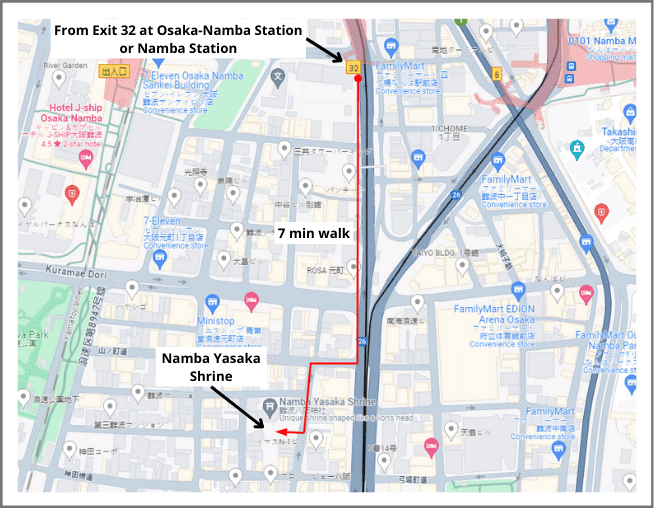
Osaka-Namba Station or Namba Station (Sennichimae Line/ Yotsubashi Line/ Midosuji Line): Leave through Exit 32 and walk for about 7 minutes to get to Namba Yasaka Shrine.
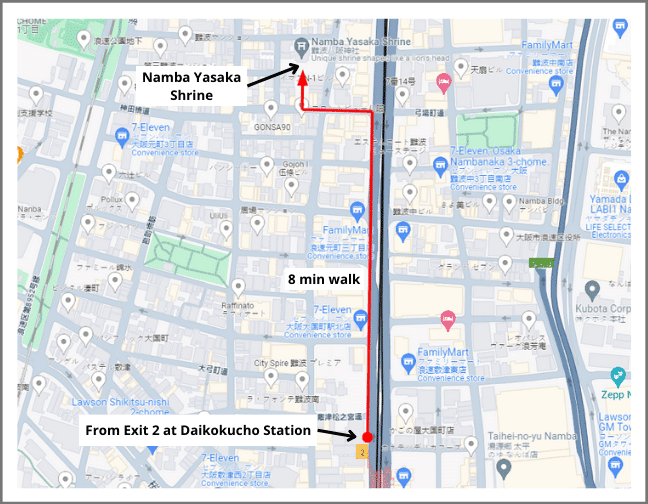
Daikokucho Station (Yotsubashi Line / Midosuji Line): Use Exit 2 and take an 8-minute walk to reach Namba Yasaka Shrine.
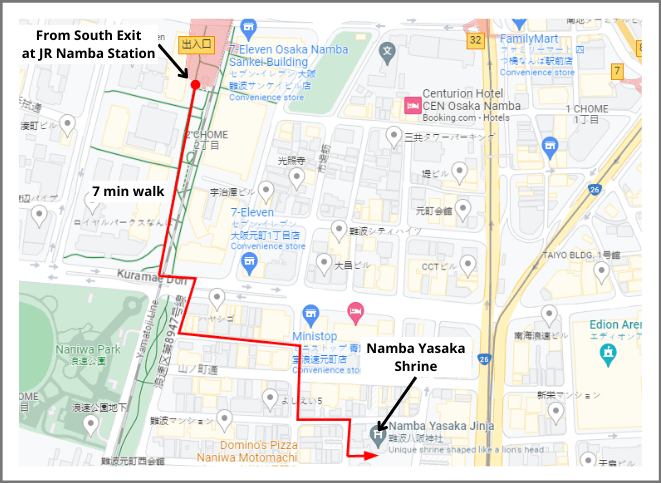
JR Namba Station (JR Yamatoji Line): Exit from the South Exit and walk for around 7 minutes to access Namba Yasaka Shrine.
Opening Hours
9:00 AM – 5:00 PM
Entrance Fee
Free
Next Stops After Namba Yasaka Shrine: Osaka’s Must-See Spots
After exploring Namba Yasaka Shrine, I suggest you visit Tsutenkaku Tower next. It’s an iconic landmark in Osaka and offers amazing views of the city.
After that, head over to Dotonbori Street for delicious food and a lively atmosphere, followed by some shopping at Shinsaibashi Shopping Street.
All these spots are close to the shrine and make for a great day out in Osaka.

